June 13, 2008
Air Date: June 13, 2008
FULL SHOW
SEGMENTS
Poverty and Dirty Diesel
View the page for this story
It's been an intractable problem - the dirtiest diesel trucks are often owned by drivers who can't afford to replace or even maintain them. But the Sea Port of Los Angeles thinks it has a solution. Living on Earth’s Ingrid Lobet reports. (08:00)
Clean Energy Crunch Time
View the page for this story
Solar, wind and other renewable energy companies are getting anxious as the clock runs out on important tax credits. The credits expire at the end of the year but Congress can't reach an agreement to extend them. Living on Earth's Jeff Young tells us what's holding them up and what's at stake for clean energy. (04:00)
Lower-Emitting Livestock
View the page for this story
In order to meet its Kyoto Protocol obligations, New Zealand must find a way to limit greenhouse gases from its biggest contributors - sheep and cattle. Mark Aspin of the Pastoral Greenhouse Gas Research Consortium is developing livestock that produce less methane. Host Bruce Gellerman talks with Aspin about New Zealand's environmental challenge, given its 40 million greenhouse-gassy sheep. (06:00)
Enviropig
View the page for this story
Animal manure on industrial farms can wreak environmental havoc. Manure contains phosphorous that leeches into waterways, causing algae blooms that can kill off marine life. At the University of Guelph in Ontario, microbiologist Cecil Forsberg has found a solution to the problem. He genetically modified pigs to produce low-phosphorous manure. The DNA Files producer Brian Mann reports. (06:20)
Bees’ Burden/Emerging Science Note
View the page for this story
Bee populations are collapsing, and new research shows pollution may have something to do with it. As Margaret Rossano reports, air pollution diminishes the scent of flowers and pollinators can’t always locate their food source. (01:40)
A Tale of Two Hives
View the page for this story
Living on Earth’s Helen Palmer is a self-proclaimed “incompetent” beekeeper but recently, something miraculous happened to her hives. She says she owes it all to her queen bee, Victoria. (03:45)
The Writing on the Wall
View the page for this story
Graffiti is plaguing many of our nation’s national parks and monuments, including some ancient Native American cliff dwellings. At Bandelier National Monument in New Mexico, conservators from a government program are taking advice from Natives, whose ancestors built these ancient sites, to make sure the restoration is done appropriately. KUNM’s Jim Williams reports. (07:00)
The Language of Landscape
View the page for this story
Living on Earth its series "Home Ground: Language for an American Landscape," based on the book of the same title edited by Barry Lopez and Debra Gwartney. In this installment, Oregon writer John Daniel muses on the word "blaze.” (01:40)
Bluegrass Plays a Greener Tune
View the page for this story
The 35th annual Telluride Bluegrass Music Festival will be greener than ever this year. Planet Bluegrass vice president Steve Szymanski tells host Bruce Gellerman about plans for carbon offsets, reusable water bottles, and the campsite challenge to encourage sustainable camping. (07:30)
Show Credits and Funders
Show Transcript
Host: Bruce Gellerman
Guests: Mark Aspin, Steve Szymanski
Reporters: Jeff Young, Ingrid Lobet, Brian Mann, Margaret Rossano, Jim Williams
[THEME]
GELLERMAN: From Public Radio International - this is Living on Earth.
[THEME]
GELLERMAN: I’m Bruce Gellerman. L.A. seaport officials want old diesel trucks to hit the road to rid the air of toxic exhaust. The city’s mayor is driving the change but says truckers shouldn’t haul the load.
VILLARAIGOSA: Truck drivers, who are barely scraping by on average at 11 or 12 dollars an hour, shouldn't have to shoulder the burden of cleaning the air for our kids!
[APPLAUSE]
GELLERMAN: Also – congress pulls the plug—again—on tax credits for renewable energies.
WETSTONE: I think you see an industry that is really mystified, and you know, they look to us and say, “I thought this was popular, we had broad support,” and it’s a very frustrating situation right now.
GELLERMAN: And – Extra, Extra. DON’T read all about it…removing graffiti in Bandelier National Monument. These stories, this week on Living on Earth. Stick around!
[MUSIC: Boards Of Canada “Zoetrope” from ‘In A Beautiful Place Out In The Country’ (Warp Records—2000)]
Poverty and Dirty Diesel
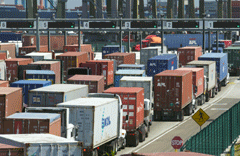
Truck traffic at the Port of Los Angeles. (Courtesy of the Port)
GELLERMAN: From the Jennifer and Ted Stanley Studios in Somerville, Massachusetts - this is Living on Earth. I’m Bruce Gellerman, in for Steve Curwood.
Pollution produced by diesel trucks is a health problem for millions of Americans. Especially dangerous are the tiny particles found in diesel exhaust. The particulates can lead to simple health problems like runny noses and more serious ailments including: asthma, lung cancer, heart disease, fetal damage, perhaps even brain cancer. The hazard is highest for those who live or work near heavy industry, roads heavy with traffic or our nation’s busy seaports. But as Living on Earth’s Ingrid Lobet reports, the Port of Los Angeles may have found a solution to the diesel truck exhaust problem.
LOBET: Over the last decade, residents have attended hearing after hearing to demand port authorities in Los Angeles and Long Beach do something about the air pollution - the soot associated with increasing international trade.
REYES URANGA: My children who were born on the west side suffer from asthma and other respiratory illnesses. We now live in a census tract that is designated as a cluster area for throat and mouth cancer. How do I care for my family's welfare?
LOBET: People were furious about the heavy trucks billowing black smoke, idling for hours and careening through neighborhoods as their drivers struggled to squeeze in two container trips a day. When Los Angeles elected Antonio Villaraigosa as mayor, he installed new leadership at the port, leaders who placed public health at the top of their agenda. Port of L.A. Executive Director Geraldine Knatz found herself facing an economic problem no one had been able to solve.
KNATZ: Right now, the majority of the truckers that come in and out of our Port are independent owner-operators. So they own their truck and they'll get a phone call from a broker who says I need you to go down to Maersk and pick up a container and take it here. A lot of them operate out of their homes, with just a cell phone and a truck.
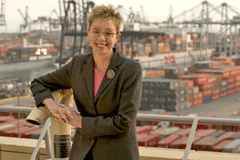
POLA Executive Director Dr. Geraldine Knatz. (Courtesy of the Port)
[AGAMENÓN SPEAKING SPANISH]
VOICEOVER: I've been hauling cargo in and out of the port 25 years. I have a 1987 truck. Here is my check for a week's work: $556.00 I need to pay $400.00 for diesel fuel. I'll take home $116.00. I also want clean air; I want to drive a clean truck. I don’t want to harm my children, or other people's children either.
LOBET: Truckers testified they wanted to be part of the solution, not the problem. But many drive old hand-me-down trucks, some with a million miles on them. Port commission president David Freeman described the result.
FREEMAN: What has degenerated here is a place where old trucks come to die. And we can't have that.
LOBET: Again Geraldine Knatz:
KNATZ: We clearly recognize that the only way we’re going to meet health standards is to turn out the whole 16 thousand trucks that come in and out of this port each week. And we’ve got like over 40 thousand truck trips a day, everyday in and out of this port.
LOBET: Port officials were hoping to expand, but were held back by lawsuits. Environmental attorneys even managed to shut down a port expansion project for a Chinese shipper.
KNATZ: We got to a situation where we were sort of dead in the water on doing anything at the port’s here because we had so many environmental issues to deal with.
LOBET: So the officials proposed changing the truck business paradigm at the Port. Their plan would eliminate most owner-operators and force cargo dispatch companies to own their own trucks, and make the drivers their employees. The vehicles will all have to be newer and clean-burning. Over the objection of trucking industry groups, port commissioners approved the idea.
FREEMAN (chairing a harbor commission meeting): All in favor: Aye, aye. It's approved unanimously.
[ROAR OF APPROVAL]
LOBET: Some local politicians say it was the biggest day of their careers. Mayor Antonio Villaraigosa spoke after the vote.
VILLARAIGOSA: Truck drivers, who are barely scraping by on average at 11 or 12 dollars an hour, shouldn't have to shoulder the burden of cleaning the air for our kids!

The Port of Los Angeles. (Courtesy of DPW)
HOLMES: We have the benefit of using this IT system not only to say this truck is pre-1989 or not, but also to say this truck should be driven by one of these 10 people, and if it is not one of these 10 people it doesn't conform.
LOBET: Since a clean-burning truck quickly becomes a dirty one if the emissions system isn't tuned regularly, the companies will also be required to maintain them.
HOLMES: So, if you’re a licensed motor carrier and you have 50 trucks, you’re gonna have to provide us your maintenance plan and we’re going to oversee the maintenance plan, and we’re going to make sure that you are maintaining the trucks.
LOBET: The port also decided to buy up old polluting trucks.
HOLMES: You know, we kind of looked at it like the programs that some of the police departments have where they buy guns, because they want to get guns off the street. We’re doing the same thing in a sense, but we’re doing it with trucks.
LOBET: But many in the business community saw the port's plan as meddling. Julie Sauls is with the California Trucking Association.
SAULS: The port of L.A. has put together a plan that, under the guise of clean air, really actually intends to change the business model of port operations.
LOBET: Sauls and other trucking organizations believe the Port's plan would allow re-unionization of the trucking industry, which became non-union when it was deregulated back in 1980.

Trucks idling at the Port of Los Angeles. (Courtesy of the Port)
LOBET: Port leadership expects to be sued by the American Trucking Association. Although the new truck program doesn't go into effect for three months, Executive Director Geraldine Knatz says expansion projects are already beginning to inch forward.
KNATZ: Our board just approved the first project that has been approved in San Pedro Bay in seven years.
LOBET: But she says:
KNATZ: We’re not out of the woods with these environmental groups. You know, they really gotta see things.
LOBET: Commission President David Freeman:
FREEMAN: We’re in a serious trust-building period. You can't expect the community to just turn off their anger like it was a neon sign. They are going to keep our feet to the fire… until it gets done.
LOBET: Knatz and Freeman believe enough dirty trucks will disappear from the port area in the next two years that residents will see - and air monitors will confirm - the air is getting cleaner.
For Living on Earth, I'm Ingrid Lobet in Los Angeles.
Related links:
- The Mayor of Los Angeles
- More about L.A.’s clean truck program
- To learn more about the American Trucking Association’s views on the plan, click here
- The Coalition for Clean and Safe Ports
[MUSIC: Medeski, Martin & Wood “Queen Bee” from ‘End OF The World Party (Just In Case)’ (Blue Note—2004)]
Clean Energy Crunch Time

Some say the sun will stop shining on the solar industry if Congress doesn’t renew clean energy tax credits. (Photo: Jackie Beck)
GELLERMAN: Renewable energy is hot – the market for solar and wind power has soared in recent years – with record-breaking growth. But people in the renewable energy business warn that the industry could come to a screeching halt if Congress doesn’t renew renewable energy tax credits. So far, lawmakers have come up short. Living on Earth’s Jeff Young tells us why and what’s at stake.
YOUNG: Look at the solar industry’s phenomenal 45 percent growth last year and you’d think this is its moment in the sun. But Solar Energy Industries Association President Rhone Resch says the outlook for next year is cloudy.
RESCH: We’ve already started to see significant sales drop-off for the photovoltaic industry and in fact we see no new concentrating solar power projects going forward. So we run a risk of very quickly going from an economic engine in this country to being another industry on the unemployment line here in the US.
YOUNG: Resch says project developers are nervous because they still don’t know if Congress will extend a critical investment tax credit for solar power, which expires at the end of the year. It’s the same story with wind power. The wind industry just had a record-breaking first quarter, installing enough turbines to power some 400 thousand homes. But with the production tax credit for wind power up in the air, the mood among wind energy companies is, in a word:
WETSTONE: Desperate.
YOUNG: That’s Greg Wetstone with the American Wind Energy Association. He says bills to extend the renewable energy tax credit have now failed four times in less than a year.
WETSTONE: I think you see an industry that is really mystified and, you know, they look to us here at American Wind Energy Association and say, “You know, what’s going on? Why can’t we get Congress to do this? I thought this was popular, and we had broad support.” And, it’s a very frustrating situation right now.
YOUNG: Renewable energy does enjoy broad support. But a conflict over tax policy mixed with election year politics makes it tough for congress to reach agreement. Congressional Democrats are sensitive to charges that they spend too much. So they want to pay for the tax credits. Montana Senator Max Baucus and New York’s Charles Schumer say that means ending some tax benefits that other businesses enjoy.

Republican Senate leader Mitch McConnell opposes using subsidies for oil companies to fund clean energy credits. (Courtesy of Mitch McConnell)
SCHUMER: And make no mistake about it, who’s the party of fiscal responsibility?
YOUNG: Republican Senate leader Mitch McConnell of Kentucky objected to Democratic proposals to pay for clean energy credits by either ending subsidies to oil companies or closing a tax loophole for hedge fund managers.
MCCONNELL: We don’t believe philosophically that in order to extend existing tax policy you should use that as an excuse to raise taxes on others.
YOUNG: On top of that, the solar industry’s Rhone Resch detects some good old partisan wrangling. As the election draws near, neither side wants to let the other claim credit on clean energy.
RESCH: Because we’re a popular issue we do get held hostage to partisan politics, which is certainly something that happens during an election year. And so both parties are looking at renewable energy in general as a political football that they can use to their advantage in the fall elections. Unfortunately, hundreds of thousands of jobs are at stake.
YOUNG: Resch fears if the partisan showdown continues congress might not act until after the November election. By then, the wind industry’s Greg Wetstone says a lot of the damage will already be done by disrupting investment and project planning.
WETSTONE: If it doesn’t happen by August we have some really serious negative impacts on our ability to continue to grow this industry, there’s no question.

Some say the sun will stop shining on the solar industry if Congress doesn’t renew clean energy tax credits. (Photo: Jackie Beck)
For Living on Earth, I’m Jeff Young in Washington.
[MUSIC: Jah Wobble “Car Ad Music 7” from ‘Car Ad Music’ (30 Hertz Records—2005)]
GELLERMAN: Coming up: fighting global warming – with a baa baa here and an oink oink there - That’s just ahead on Living on Earth.
Related links:
- Solar Energy Industries Association
- Analysis of the economic impact of tax credits
- American Wind Energy Association on tax credits
- Senators’ voting records on clean energy tax credits
[MUSIC: Frank Zappa: “Toad Of The Short Forest” from Weasels Ripped My Flesh (Rykodisc 1995)]
Lower-Emitting Livestock
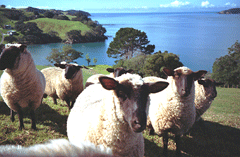
Sheep and other livestock are the source of New Zealand’s biggest greenhouse gas problem. (Photo: Kurt Weyerhauser)
GELLERMAN: It’s Living on Earth, I’m Bruce Gellerman.
Global warming skeptics argue that people aren't to blame for causing climate change and maybe they have something: sheep, cows, and farmed deer are also doing their part to warm up the planet. It seems the animals emit two of the most powerful greenhouse gases. And in a place like New Zealand, where they raise 40 million sheep, 10 million cows, and a million deer, developing less gassy farm animals is a national priority. There are 25 full-time researchers working at the Pastoral Greenhouse Gas Research Consortium in Wellington. Mark Aspin manages the project. Welcome to Living on Earth.
ASPIN: It’s nice to be here.
GELLERMAN: Mr. Aspin, I understand you grew up on a farm. Is that right?
ASPIN: Yes, I have, yup.
GELLERMAN: So you were very familiar with this problem for a long time.
ASPIN: Well, I was in farming, dairy farming and sheep farming for some years, but I didn’t realize we were producing methane and nitrous oxide, which are greenhouse gases. So I’m familiar with farming livestock, yes. And ruminant animals which sheep, cattle, and deer are when they digest forage in their first stomach, the rumen, have a bi-product of methane, one of the major greenhouse gases. And also, the urine and dung that’s excreted out the other end can lead to nitrous oxide, which is also a greenhouse gas.
GELLERMAN: Forgive me if this is not a polite question, I’m not sure how to ask it, but is the problem belching or is it flatulence?
ASPIN: It’s belching. What actually happens is in the fore-stomach of a ruminant animal there’s a big bag where you’ve got lots of microbes. And the animals graze and eat their forage, chew it, and inside that first stomach there’s basically a big fermentation occurring breaking down all the plant material so that the animal can get the nutrients from it.
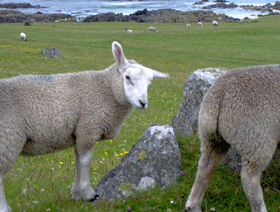
Most of the methane emitted by sheep actually comes through their mouths. (Photo: Christine Macintyre)
GELLERMAN: I’m sure you’ve heard every joke there’s possibly could be made about this and, uh, but it’s –
ASPIN: No, I’ve never, you’ve never heard every joke. [LAUGHTER] I’ve heard plenty.
GELLERMAN: But this is a very real problem.
ASPIN: Well it’s a real problem and there’s a lot more cattle and sheep around the world than there is in New Zealand so it’s not just our problem it’s an international issue and you’ll find in most developing countries large numbers of livestock. Livestock account for about 14 percent of global greenhouse gas emissions so it’s not insignificant in numbers. Um, the issue for New Zealand is that we’ve got an economy strongly built around agriculture and that means that we have about 48 percent of our total greenhouse gas emissions come from agriculture, from methane and nitrous oxide. We’re unique as a developed country in that we’ve got such a strong profile for agricultural greenhouse gases as opposed to more developed, other developed countries that have a lot more coal and energy greenhouse gas emissions.
GELLERMAN: Now you’re under the gun because, you know, according to the Kyoto agreement you’ve got to reduce very significantly emissions by, what, 2012.
ASPIN: And now I’m talking to the U.S. Yes we’ve got to reduce our emissions back to 1990 levels so that for New Zealand is about a 20 to 25 percent reduction across our whole economy. And here we face a significant carbon cost in the future and that’s the reason that the country and the industry has engaged in research to try and see whether we can mitigate that problem and reduce that cost.
GELLERMAN: So where is the most fruitful part of your research taking you? Where do you think you can really make significant cuts?

Sheep and other livestock are the source of New Zealand’s biggest greenhouse gas problem. (Photo: Kurt Weyerhauser)
GELLERMAN: What about cloning? I mean, we’ve cloned a sheep, Dolly the sheep. Could you clone a sheep that wouldn’t, well, fart?
ASPIN: Well, certainly that’s not an avenue that we’ve been looking at. We’re using traditional and natural methods of reproduction. We have been looking at animal selection to see whether we can find high and low emitting sheep or cattle and then perhaps if we can identify those animals and breed from them, that’s a long term solution that’s part of our approach to this issue as well.
GELLERMAN: Yeah, and Prime Minister Helen Clark has set as a national goal of New Zealand to become the world’s first carbon neutral country.
ASPIN: I wouldn’t want to comment on that. Yeah I actually she certainly has said that so here we’re pretty conscious about trying to be, do the right thing. We only account for .2 percent of the world’s greenhouse gases emissions. So we’re very small in the global scale but we’d like to believe that we can still be leaders and do the right thing.
GELLERMAN: Well Mr. Aspin I want to thank you very much. I really appreciate your time.
ASPIN: Ah you’re welcome and haere ra.
GELLERMAN: Hi dee grah?
ASPIN: Haere ra, it’s just farewell.
GELLERMAN: Well, haere ra, Mr. Aspin.
ASPIN: That’s alright.
GELLERMAN: Mark Aspin manages the Pastoral Greenhouse Gas Research Consortium in Wellington New Zealand, which is trying to cap global warming coming from sheep, cows, and deer.
Related link:
The Pastoral Greenhouse Gas Research Consortium
Enviropig
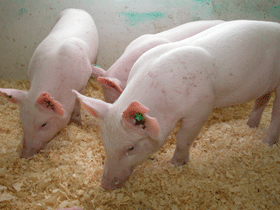
The newer, cleaner pigs. (Photo: Dr. Cecil Forsberg)
Well, closer to home pigs are a problem. Seems when pigs pig-out, they produce polluting phosphorus, which is why one Canadian scientist has been working for years to market “Enviropigs”—animals genetically engineered to be kinder to the environment.
Brian Mann has our story, which originally aired on “The DNA Files”.
MANN: A mile outside of Guelph, Ontario, the tree lined streets give way to fields and stretches of wood. Microbiologist Cecil Forsberg points me down a gravel drive towards what looks like a modern industrial farm.
FORSBERG: You make a left turn. I’d stay away from the front door where your vehicle can pick up the smell.
MANN: It’s a rental. So I don’t mind the smell.
[CECIL LAUGHS]
MANN: We park a safe distance away. Despite the wind, there is an odor—cows and mowed grass, but overwhelming it all, the sickly sweet stench of pig manure. Forsberg opens the door to a sprawling barn operated by the University of Guelph. The building is part pigsty, part high tech laboratory. Massive fans churn constantly, maintaining the temperature and easing the odor. Pigs are famous for eating a lot, and it turns out they’re not very efficient at digesting the kind of corn and soybeans that make the cheapest livestock feed. As a consequence, their poop is thick with undigested waste products, including phosphorous. For 11 years, this has been Cecil Forsberg’s obsession.
FORSBERG: We thought this would be an ideal project to undertake, because of the extensive phosphorous pollution one finds within areas where there’s very intensive livestock production.
MANN: The phosphorous problem is a conundrum of modern agriculture. As the human population grows, we require more and more food. That means more cows and pigs, which industrial farmers have supplied pretty handily. But the side effects of those huge factory farms can be devastating.
WATZIN: Oh, we have a crème de la crème spot. We’re right on the waterfront in Burlington.
MANN: Mary Watzin is director of the Rubinstein Ecosystems Science Laboratory on Lake Champlain. The lake is beautiful, a huge craggy waterway that cuts between Vermont, New York State, and Canada. But phosphorous run-off from large pig and dairy farms has trigged disgusting algae blooms.
WATZIN: You wouldn’t miss it, if you saw it. The water looks like there’s green stuff in scums on the surface.
MANN: Algae can create conditions that gobble up a lake’s oxygen. Watzin says, suffocating fish, and throwing the natural ecology into a tailspin. In recent years, toxic concentrations have risen, and several animals exposed to the algae have died.
WATZIN: There are two toxins, actually, produced in Lake Champlain. One is a neurotoxin or brain toxin, and that’s been responsible for most of the dog deaths.
MANN: Half a dozen dogs have died, Watzin says. The other toxin found during autopsies destroys liver tissue. No humans have been affected so far, because the algae looks so gross that people won’t go near it. But a lot of towns along the shore still draw their drinking water from the lake and as industrial agriculture spreads around the world, producing more and more phosphorous, Watzin says precious water sources are gumming up with this algae soup, which brings us back to Cecil Forsberg’s “Enviropig.”
[PIG NOISES]
MANN: Forsberg wades into a pigpen, waist deep in what looked like everyday Yorkshires, pale skinned, rubbery nosed pigs. The unique thing about these animals isn’t their voracious appetites, but a genetic modification with their salivary glands. Remember how pigs aren’t very good at digesting the phosphorous in corn and soybeans? Well, it happens that some bacteria are great at it. They naturally produce an enzyme that dissolves the phosphorous.

The newer, cleaner pigs. (Photo: Dr. Cecil Forsberg)
FORSBERG: Although we haven’t eaten any of the pork—in fact, it’s illegal until there’s regulatory approval—I am 99.9 percent confident that the flavor of the pork from these pigs will be equivalent to that from conventional pigs.
MANN: But there’s a wrinkle. Pig farmers in Ontario helped to fund the first round of “Enviropig” research, but the project still faces years of testing and regulatory hurdles, and the big grants from an industry group called Ontario Pork have dried up.
FORSBERG: I’m embarrassed to admit it, but we have no genuine commercial interest in these pigs.
MANN: Could I have a ham and swiss? Actually I’d rather have a BLT, please.
[RESTAURANT HUM]
MANN: After touring the farm, he takes me to a Tim Horton’s restaurant. The fast food chain is everywhere in Canada, one more link in our industrial food economy. Forsberg looks around at the crowd grabbing a quick lunch. As the world’s population grows, so will our hunger for those BLT and ham sandwiches, which means more pigs, more polluted waterways, and more toxic algae blooms.
FORSBERG: I don’t view this scientific advancement as being one to increase the quantity of food. I view it as a trait within an animal that reduces its environmental impact. Sustainability, I think, is the key issue, which I would raise.
MANN: I’m Brian Mann.
GELLERMAN: Our story on the Enviropig comes to us courtesy of SoundVision Productions in Berkeley, CA.
Related links:
- Guelph Transgenic Pig Research Program
- The DNA Files – “Designing the Garden: Food in the Age of Biotechnology”
[MUSIC: The Beatles “Piggies” from ‘The White Album’ (EMI Records—1968)]
Bees’ Burden/Emerging Science Note
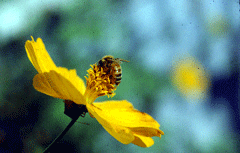
[MUSIC: "Track 70 - Bee Swarm" from 'The Ultimate Digital-Stereo Sound Effects Library, Nature and Animals' ]
There's been a lot of buzz in the news lately about bees. That's because U.S. bee populations both honeybee and wild—have plummeted.
[THEME MUSIC]
Honeybee colonies have declined by almost half in the past 60 years. Scientists aren't sure exactly what's causing so-called Colony Collapse Disorder, but a recent study by a research team at the University of Virginia suggests that air pollution may have something to do with it.
Emissions from vehicles and industry contribute to the formation of air pollutants like ozone. The scent molecules produced by flowers - which help pollinators find them - are extremely volatile, and bond easily with these pollutants.
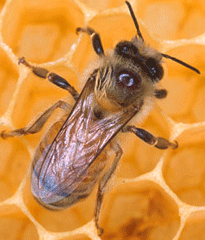
(Courtesy of the NIH)
The team found that air pollution destroys flowers' aroma by as much as 90 percent. Scent molecules that once traveled three quarters of a mile may now migrate less than one quarter of a mile.
Because scent molecules cover only a short distance before they are chemically altered, it's much more difficult for pollinators to find them. Bees struggle to find food, and flowering plants suffer because they're not pollinated.
It looks like bees may be yet another reason why we need to curb air pollution.
That's this week's note on emerging science. I'm Margaret Rossano.
A Tale of Two Hives
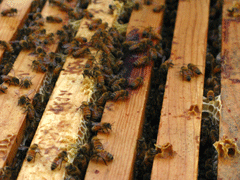
Helen Palmer's bees.
PALMER: I have two bee hives on my back deck.
GELLERMAN: That’s our managing producer, Helen Palmer, who came into work this week and told us a story with a sweet ending.
PALMER: Over the winter, the bees in one of my hives died. No, it probably wasn’t colony collapse disorder – that’s much more a problem for commercial bee-keepers, who truck their bees up and down the country than for hobbyists like me.
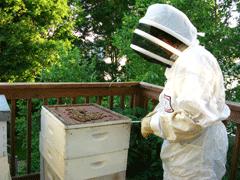
Helen Palmer timidly approaches her hive.(Courtesy of Helen Palmer)
Then I cleaned it out and it seemed such a waste that I changed my mind. Too late – I told you I was incompetent. In April and May you can order three pound packages of bees from lots of breeders; they arrive in the mail. But by June – everybody’s sold out!
Now there is another way of filling an empty hive. You can steal bee-eggs – they’re called brood – from a healthy hive and relocate them. A hive’s kind of like a file cabinet with hanging folders. The queen bee – I call mine Victoria – lays eggs in honeycomb cells that the worker bees build on these folders – they’re called frames.
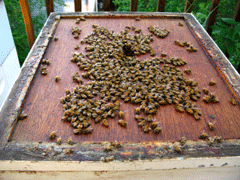
Helen's hives.
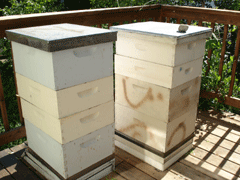
(Courtesy of Helen Palmer)
So to restock a hive you take about three frames and the bees that are hanging out on them and put them in the other hive. Then you order up another queen – they’re shipped overnight from Georgia – and put her into that hive. She lays lots more eggs, and builds up the strength of the colony. But there’s a snag: the bees aren’t too happy when you invade their home and steal their babies, - they tend to attack very aggressively and, as I told you, I’m scared of bees.
Still I was game to take some frames from my healthy hive—it’s just a foot away from the dead one. Then events – or rather the bees - took the decision out of my hand. About nine o’clock last Saturday, suddenly, outside on the deck, the air was thick with bees – bees zooming and buzzing frantically – a whirlwind of bees stretching way up into the sky and way out across the garden. And then – almost as soon as the commotion had started – the swarm was gone. Half the hive just flew off and away.
Now, it’s not actually uncommon – if bees feel they need more space, they DO swarm – but I was dejected. Queen Victoria was gone - my healthy hive was only at half strength – and there was no way I could take brood away from it to repopulate the dead hive. But I was relieved too, I suppose. I mean even if I’d harvest much less honey, at least I wouldn’t have to fight the angry bees.
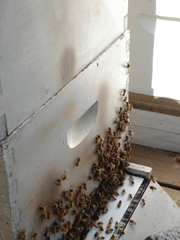
(Courtesy of Helen Palmer)
But the more I thought about it the more logical it became. I may be an incompetent beekeeper, but bees have been creating colonies, raising brood, and making honey for millennia. They think as one organism – it’s called hive mind. And I have to believe that these bees of mine understood my shortcomings, and took pity on me.
They knew I couldn’t possibly manage to resurrect the dead hive – that I’d squash plenty of them trying and they’d have to sting me – so they saved us all the pain and trouble. So thank you Queen Victoria! I promise not too take too of your much honey!
GELLERMAN: When Helen Palmer isn’t tending her bees – she’s producing our program.
[MUSIC: Memphis Slim “Queen Bee” from ‘Memphis Slim: Favorite Blues Singers’ (Smithsonian Folkways—1973)]
GELLERMAN: Coming up – don’t read all about – graffiti in a national monument. Stay tuned to Living on Earth.
ANNOUNCER: Support for the environmental health desk at Living on Earth comes from the Cedar Tree Foundation. Support also comes from the Richard and Rhoda Goldman Fund for coverage of population and the environment. And from Gilman Ordway for coverage of conservation and environmental change. This is Living on Earth on PRI—Public Radio International.
The Writing on the Wall
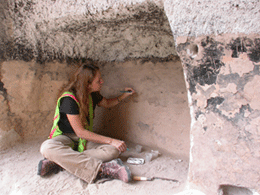
Angelyn Bass Rivera, architectural conservator with the National Park Service, restores a section of a Bandelier cavate. (Courtesy of National Park Service)
[MUSIC: Nicholas Payton: “Let It Ride” from Into The Blue (Nonesuch Records 2008)]
GELLERMAN: It’s Living on Earth. I’m Bruce Gellerman.
Graffiti’s typically found on subway cars and the walls and structures of the inner city. But far from the urban canyons you’ll also find graffiti in the remote canyons of New Mexico. At Bandelier National Monument in New Mexico, vandals have been desecrating the ancient cliff dwellings. And cleaning up the graffiti has created a conundrum – how to do it in a culturally appropriate way.
Jim Williams from public radio station KUNM has our story.
[OLD SCREEN DOOR SQUEAKING OPEN AND CLOSED]
WILLIAMS: Larry Humetewa steps out of his old stone building office with a couple of buckets. He’s about to head up the canyon trail here in New Mexico’s Bandelier National Monument to deal with graffiti park visitors have left on some of the 800 year old cliff dwellings.
HUME: We have to bring out our field material, which consists of a couple of different clays, some red tuff, grey tuff, trail sand, tools we call microspatulas.
WILLIAMS: Humetewa is on the restoration team for Vanishing Treasures, a National Park Service program that has, since the late 1990s, provided extra funding and expertise to help protect and stabilize ancient archeological sites at national parks and monuments across the Southwest. The program’s been called a “last defense” against losing sites like these. And there is plenty of defending to do. In the case of Bandelier’s graffiti, up to a quarter of the 1100 ancestral pueblo sites here have now been vandalized by visitors. Humetewa is from Santo Domingo Pueblo, a reservation about forty miles to the south. It’s likely his ancestors built these ancient dwellings.
HUME: You know, it’s very important. I do feel that connection, you know.
[FRIJOLES CREEK, WIND IN TREES]
WILLIAMS: Frijoles Creek runs through a beautiful forest of old ponderosa pine, douglas fir, and gambel oak along the canyon bottom here in Bandelier. Through the trees, on either side, the sun shines on cliff walls that rise hundreds of feet into the air. They’re filled with ancestral dwellings used by generations of American Indians. Humetewa glances up at them.
[WALKING ALONG CREEKSIDE TRAIL]
HUME: Every time I, you know, drive down the hill, it’s a special place. And knowing that my ancestors lived here and played here and worked here, and made pots and textiles here. You know, I try to stay positive while I’m working, you know basically what we’re always told to do: just stay positive, respect the place and the people that lived here.
WILLIAMS: On the way up the trail toward the cliffs, we pass a sign that states clearly: “it’s illegal to deface cave dwellings.”
HUME: Yeah, I think they oughta, I don’t know, put more signs in different languages. [laughs] I don’t know. They just seem to ignore them. Even way down there where we’re working at, there’s signs, you know, right in front of you.
[CLIMBING SQUEAKY WOODEN LADDER]
WILLIAMS: We climb the ladder made out of small logs up into one of the cavates, a round room about eight feet high and fifteen feet deep carved into the compressed volcanic ash, or “tuff,” of the cliff wall.
HUME: We probably started “c”, and then an “o” over here.
WILLIAMS: Humetewa waves his hand across where someone had carved the name of an old Spanish conquistador, Coronado. In another spot, a visitor had written his own name: Leonardo. That one was difficult to cover because it sprawled across the wall. But if Humetewa wasn’t pointing at it, no one would ever know it’d been there.
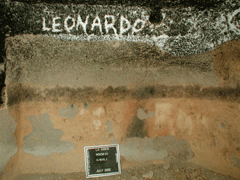
Leonardo carved his name on this ancient cavate wall. (Courtesy of National Park Service)
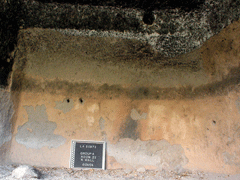
The same cavate wall after graffiti mitigation treatment. (Courtesy of National Park Service)
WILLIAMS: That’s clearly important to Humetewa, because he takes the graffiti personally.
HUME: To me, it’s like coming into my house and carving your name on my wall. You know, that’s how I feel that these are disrespectful. I wouldn’t go into anybody’s house and carve my name into their wall.
WILLIAMS: For the restoration, the process of color and texture matching is meticulous: tuff mixed with trail sand, lime, ionized water, and pigment. The mix and the application have to be rough-textured to match the way the walls are naturally eroding.
[SCRAPING AND MIXING IN A SMALL CUP]
HUME: Yeah, you don’t wanna add too much water ‘cause it’s just gonna get too watery…
[SPRAYING WATER]
WILLIAMS: Humetewa sprays water over the graffiti to moisten the wall so the material will stick to it. The mix is then carefully applied by spatula over the carved graffiti.
[SPATULA SCRAPES, FADE DOWN TO SILENCE]
[FADE UP, VISITORS TALKING IN ANOTHER CAVE]
MCMAHON: The graffiti in this cave is so severe…before it was treated it was so severe that there was basically little to no original material left.
WILLIAMS: That’s Conor McMahon, Humetewa’s restoration partner. This cavate, about three hundred feet down the cliff from the other, originally had a black ceiling, created by centuries of smoke from burning wood in it. It has, over time, become a chalkboard of sorts for people to carve their own messages: initials, names, profanity. McMahon says that here, he and Humetewa had to break from their traditional method of just covering over individual graffiti markings. As many as four times a year, in the hot high desert sun, they have to re-soot the whole thing.

Angelyn Bass Rivera, Architectural Conservator with the National Park Service, restores a section of a Bandelier cavate. Graffiti mitigation involves the infilling of graffiti that has been etched or carved into the original tuff and plaster surfaces in the cavates. (Courtesy of National Park Service)
WILLIAMS: This room, and many others like it here, were sacred places for generations, and to their descendants they still are.
MEYER: Their perspective on sites like this are that these sites are still occupied by their ancestors - that life is very cyclical.
WILLIAMS: Lauren Meyer is an architectural conservator with the Vanishing Treasures Program at Bandelier. She says the program has consulted with the current pueblo people in the area, including Larry Humetewa, to make sure restoration is done correctly.
MEYER: You know, their ancestors live on in these sites, and these sites, you know, are supposed to erode naturally. It’s all about coming from the earth and going back to the earth, and Larry brings that perspective to us which helps inform our decisions about treating these sites.
[BIRDS, CREEK]
WILLIAMS: About 25,000 dollars a year is dedicated to treating these sites at Bandelier. Lauren Meyer and other preservation advocates say that's barely enough to continually treat these sites and educate the public about their cultural history. The Vanishing Treasures program focuses almost exclusively on Southwest parks, where many ancient cultural sites exist. But other national parks and monuments around the country have little funding for restoration programs. One former parks director called the lack of funding "an undeniable crisis in care" and it's sure to affect historical parks around the country for years to come.
For Living On Earth, I'm Jim Williams in Bandelier National Monument in New Mexico.
Related links:
- Vanishing Treasures Program
- Bandelier National Monument
The Language of Landscape

GELLERMAN: Well, Bandelier National Monument gets its name from Adolph Bandelier, a Swiss archeologist who studied ancient Pueblo Indian sites. The language that we use to describe our landscape often has origins and meanings that are lost to us now. The book “Home Ground: Language for an American Landscape” reminds us of where the terms that define our environment come from. The book was compiled by Barry Lopez and Debra Gwartney and from time to time we’ve been featuring some of those terms on Living on Earth.
Today - writer John Daniel and his description of the term “blaze”.
DANIEL: Blaze. Blaze, meaning a white patch on a horse’s forehead, was applied by English colonists to the marking of a forest route by periodically axing off a piece of tree bark to expose a portion of lighter-colored wood.

GELLERMAN: John Daniel is a writer whose Home Ground is the foothills west of Eugene Oregon. His description of ‘blaze’ came from “Home Ground: Language for an American Landscape” compiled by Barry Lopez and Debra Gwartney.
[MUSIC: Joni Mitchell: “Refuge From The Road” from Hejira (Asylum Records 1975)]
GELLERMAN: For 35 years the Telluride Bluegrass Festival has been going strong.
Bluegrass Plays a Greener Tune

Festival coordinators require that all the garbage produced at the festival be composted or recycled. (Photo: Benko Photographics)
[MUSIC: Telluride Festival: Ricky Skaggs “Get Up John” from Choice Picks 10th Anniversary Ibma Awards (Sugar Hill Records 1999)]
GELLERMAN: This year it’s going all green. The Telluride Bluegrass Festival will be 100 percent carbon neutral. All its carbon dioxide emission will be offset by clean energy technologies. It’s part of a trend - the Montreal International Jazz Festival, the Sasquatch music festival in Washington, and the Bannaroo music festival in Tennessee are also members of the carbon neutral choir.
At Telluride, Colorado 10,000 festivarians as they’re called, will gather in a canyon surrounded by the San Juan Mountains. And for four days around the summer solstice they’ll cook, camp and of course listen to live music in a carbon clean environment.
[MUSIC: Telluride Festival: Ricky Skaggs “Get Up John” from Choice Picks 10th Anniversary Ibma Awards (Sugar Hill Records 1999)]
GELLERMAN: Steve Szymanski is vice president of Planet Blue Grass, which produces the Telluride Festival. Mr. Szymanski, welcome to Living on Earth.
SYZMANSKI: Thank you very much and please call me Steve.
GELLERMAN: Okay Steve, thanks. Boy, this bluegrass festival: very ambitious. Carbon neutral?
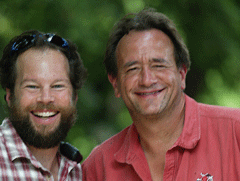
Steve Szymanski & Craig Ferguson of Planet Bluegrass. (Photo: Laura Klein)
GELLERMAN: And I guess the large majority of the carbon is coming from exactly that, people getting to Telluride.
SYZMANSKI: It really is and that was one of the things we realized in pretty short order, well over 90 percent of all the emissions created were from travel. It’s exacerbated by the fact that Telluride is in the middle of nowhere if there’s still such a place in the country.
GELLERMAN: How do you hope to make all that travel carbon neutral?
SYZMANSKI: Well, first with uh, looking at efficiencies, and we have a pretty aggressive carpooling program and then obviously there’s going to be a certain number of cars that just have to make the drive so what we’ve been doing more the last couple years is offsetting with projects that are going on around the country now in landfills. So we’re working with a huge landfill in Illinois with 195 acres to sequester all the methane from that landfill. The methane actually is used then used to create energy for the community and this is basically done with the help of folks like us and other people who are out there looking to put their money into these projects.
GELLERMAN: So Steve how much carbon are you hoping to offset?
SYZMANSKI: Well this year that number comes in to right around 5.7 million pounds of carbon. That is equal to taking 500 cars off the road forever.

“Festivarians” bring solar panels to power their campsites while at the festival. Two hydropower stations are also available to campers. (Photo: Benko Photographics)
[LAUGHTER]
SYZMANSKI: Well you know again take water for instance. It’s kind of evolved over the years but in 2004 we were working with a local business down there that developed the first corn plastic water bottle in the world. Part of the thing is we’ve really been mandating at the festival now is everything in the festival grounds must be recyclable or compostable. And so having this you know compostable bottle was you know were touting it off, “look at us, we’re cool, we have the ability to throw this in our compost pile.”
We’ve come to realize through lots of reading and you know other dialogues we’ve had that bottles no matter what you’re doing you still have a waste stream, you still have to drive it somewhere, you still have that carbon footprint, so why not get rid of the bottles entirely. That’s kind of one of our new initiatives this year is to really go back to drinking local water so we’re pretty excited that we’re going to have a wonderful, free filtered water station for all our audience and they can bring a reusable bottle and let’s not have any plastic at the festival.
GELLERMAN: People can bring tin cups like they used to use back in the old days of silver mining.
SYZMANSKI: You know it’s funny we’re going right back to that the stainless steel mug, we have a kleen canteen product, all our artists are going to get a nice calligraphied kleen canteen with their name on it and from the stage they’re going to be sending the same message that our audience is sending.
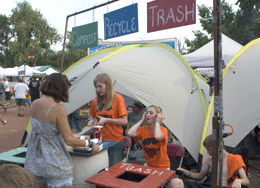
Festival coordinators require that all the garbage produced at the festival must be compostable or recyclable. (Photo: Benko Photographics)
SYZMANSKI: We have a whole backstage catering for our artists and families and guests of approximately a 1,000 meals a day. One of the initiatives back there in the last couple years was really looking at the food footprint. You know the organics were definitely high on the list but what we realized is really local food, sourcing local food, is just as important if not more important than sourcing organic food. And happy to say that even in June in Telluride we’re able to get all of our dairy from Colorado, we’re able to get chicken from Colorado, we’re 75 percent now all organic menu for our backstage. And we’d love to see the vendors out front do that but you know we want to be able to prove to ourselves that yes we can go organic, we can source local and then once we’ve, we feel like we’re doing that and it’s possible then we’ll ask our vendors to do that as well.
GELLERMAN: You just got some real headliners: Ani DiFranco, Arlo Guthrie of course. One of the bands I’ve never heard of, I must admit, is Leftover Salmon.
SYZMANSKI: Well they came right out of the camp ground in Town Park in Telluride back in the late eighties and nineties and that is really a Colorado jam band. Everyone’s really looking forward to that because that’s a good, good raucous late night set, keep everybody dancing and keep everybody warm.
[MUSIC: Leftover Salmon: “Bend In The River” from Ask The Fish (Bert Records 2004)]
GELLERMAN: I understand that this is actually the second year that you have something called the “Campsite Challenge.” How green is your campsite?
SYZMANSKI: Well what we ask people to do is just to think about what they’re bringing to the event and making sure that everything they bring has a useful purpose but then also gets brought back out of the event and then think about ways you can generate electricity. We actually have two hydro stations set up on the river for campers who want to use you know want to grind their espresso beans. We have lots of solar panels coming into the festival grounds: there’s just a lot of ingenuity in these camp grounds and so we want to begin incentivize that behavior but also we want to honor these people that are really going all out.

Festival coordinators are hoping to get vendors to buy organic and locally grown foods for future festivals. (Photo: Benko Photographics)
SYZMANSKI: You know I do, but I really think our venues out here in Colorado really just speak to the beauty and the pristine nature of Telluride. Folks immediately get it—I think its wired in that this is a beautiful place, we need to keep this place beautiful, and we need to preserve it. And so we’re lucky enough I think to have nature in everyone’s face all the time and so I think it’s been a little easier messaging around that because it’s just so obvious that this kind of environment is only possible if we take care of our event.
GELLERMAN: Have any of your performers come up with a carbon neutral song for the show?
SYZMANSKI: The Barenaked Ladies made up a song, like they frequently do, a couple years ago and they actually threw in some fun comments about the greening of the event but that was as close as we got.
GELLERMAN: Well Steve thank you very much I really appreciate it. Have a great time at this year’s festival.
SYZMANSKI: We certainly will. Thank you very much.
GELLERMAN: Steve Szymanski is vice president of Planet Blue Grass, which produces the Telluride Bluegrass Festival.
Related links:
- Telluride Bluegrass Festival
-
[MUSIC: Bare Naked Ladies “Improvised song from the 2007 Telluride Bluegrass Festival courtesy of Planet Bluegrass Productions]
GELLERMAN: On the next Living on Earth: Population and the environment – a new book says women are the key to regulating both:
Engleman: There’s a new Idaho basically every week – and that’s people, not potatoes – and it has a major major impact on all the environmental problems we face and the best way to address it is to give women literally what they want.
GELLERMAN: What women want…and why that’s best for the environment, next time on Living on Earth.
GELLERMAN: Living on Earth is produced by the World Media Foundation. Our crew includes Ashley Ahearn, Bobby Bascomb, Eileen Bolinsky, Ingrid Lobet, Helen Palmer, Mitra Taj and Jeff Young, with help from Jennifer Baessler, and Sarah Calkins.
Our interns are Kim Gittleson and Jessica Ilyse Smith. Jeff Turton is our technical director. Alison Lirish Dean composed our themes. Special thanks this week to the National Parks Conservation Association. You can find us at Living on Earth dot org. Steve Curwood is our executive producer. I’m Bruce Gellerman. Thanks for listening.
ANNOUNCER: Funding for Living on Earth comes from the National Science Foundation, supporting coverage of emerging science, and Stonyfield Farm: organic yogurt and smoothies. Stonyfield pays its farmers not to use artificial growth hormones on their cows. Details at stonyfield.com. Support also comes from you our listeners, the Ford Foundation, the Town Creek Foundation, the Oak Foundation supporting coverage of climate change and marine issues. The Bill and Melinda Gates Foundation, dedicated to the idea that all people deserve to live a healthy and productive life. Information at gatesfoundation dot org. And Pax World Mutual Funds: socially and environmentally sustainable investing. Pax World: for tomorrow. On the web at paxworld.com.
ANNOUNCER 2: PRI: Public Radio International.
Living on Earth wants to hear from you!
Living on Earth
62 Calef Highway, Suite 212
Lee, NH 03861
Telephone: 617-287-4121
E-mail: comments@loe.org
Newsletter [Click here]
Donate to Living on Earth!
Living on Earth is an independent media program and relies entirely on contributions from listeners and institutions supporting public service. Please donate now to preserve an independent environmental voice.
NewsletterLiving on Earth offers a weekly delivery of the show's rundown to your mailbox. Sign up for our newsletter today!
 Sailors For The Sea: Be the change you want to sea.
Sailors For The Sea: Be the change you want to sea.
 The Grantham Foundation for the Protection of the Environment: Committed to protecting and improving the health of the global environment.
The Grantham Foundation for the Protection of the Environment: Committed to protecting and improving the health of the global environment.
 Contribute to Living on Earth and receive, as our gift to you, an archival print of one of Mark Seth Lender's extraordinary wildlife photographs. Follow the link to see Mark's current collection of photographs.
Contribute to Living on Earth and receive, as our gift to you, an archival print of one of Mark Seth Lender's extraordinary wildlife photographs. Follow the link to see Mark's current collection of photographs.
 Buy a signed copy of Mark Seth Lender's book Smeagull the Seagull & support Living on Earth
Buy a signed copy of Mark Seth Lender's book Smeagull the Seagull & support Living on Earth

